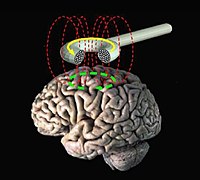
Photo from wikipedia
Introduction ET is a common movement disorder. It is not life threatening, but it can significantly impair patients’ activities of daily living. Beta-blockers and primidone have been used as the… Click to show full abstract
Introduction ET is a common movement disorder. It is not life threatening, but it can significantly impair patients’ activities of daily living. Beta-blockers and primidone have been used as the treatment of choice for patients with ET. However, up to 50% of ET patients report that they are not satisfied with the improvement of tremor symptoms by these medications. We investigated effect of cerebellar low-frequency repetitive transcranial magnetic stimulation (rTMS) as an ‘add-on’ treatment on patients with Essential tremor (ET). Methods This was a single-center, prospective, sham-controlled and single-blinded study. Fourteen ET patients participated. ET was diagnosed when the patient had bilateral postural or kinetic tremor of the arms, no dystonia and no possibility of drug-induced secondary tremor. In addition, we included subjects in this study only if they had residual significant tremor despite beta-blockers and other drugs as symptomatic management. Subjects were randomized into a group receiving real-rTMS and another group receiving sham-rTMS. rTMS was applied over each side of the cerebellum in turn. The order of the stimulation to each side was randomly assigned. For 5 days, 600 stimulations a day were applied with an intensity of 90% of the resting motor threshold (RMT) with 1-Hz frequency. Clinical tremor rating scale (CTRS) was measured before, a week and 5 weeks after starting day of the rTMS procedure. Results Eight and 6 patients were randomized to the groups of real and sham-rTMS, respectively. The mean age, symptoms duration and baseline CTRS scores were comparable. ANOVA analysis showed that all three parts (A, B and C) of CTRS were not different before, a week and 5 weeks after starting rTMS procedure both in real and sham-rTMS groups. There were no adverse events including headache, dizziness, syncope and seizure. Conclusion Cerebellar low-frequency rTMS is safe but not effective as an ‘add-on’ therapy in patients with ET.
Journal Title: Clinical Neurophysiology
Year Published: 2018
Link to full text (if available)
Share on Social Media: Sign Up to like & get
recommendations!